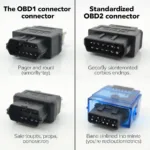OBD2 mandatory regulations have revolutionized vehicle diagnostics and emissions control. This article explores the importance of OBD2, its mandatory status, and the impact it has on vehicle owners and the automotive industry. We’ll delve into the history, benefits, and future of this essential technology. See our page on when was obd2 mandatory for more details.
The History of OBD2 and its Mandatory Status
The Clean Air Act Amendments of 1990 paved the way for OBD2 to become mandatory in the United States. Initially, the goal was to standardize diagnostic trouble codes (DTCs) across all vehicle makes and models. This standardization simplified diagnostics for technicians and facilitated easier repair of emissions-related issues.
Why Did OBD2 Become Mandatory?
The primary reason for making OBD2 mandatory was to reduce air pollution from vehicles. By providing a standardized system for monitoring emissions systems, OBD2 allows for quicker detection and repair of malfunctions, preventing excess pollutants from entering the atmosphere. The mandatory implementation also leveled the playing field for independent repair shops, giving them access to the same diagnostic information as dealerships.
Benefits of OBD2 Mandatory Regulations
The mandatory implementation of OBD2 has yielded numerous benefits for both vehicle owners and the environment. These benefits include:
- Early Problem Detection: OBD2 continuously monitors vehicle systems, allowing for early detection of potential problems before they escalate into major repairs.
- Reduced Emissions: By ensuring proper functioning of emissions control systems, OBD2 significantly reduces harmful pollutants released into the atmosphere.
- Improved Fuel Economy: A properly functioning engine, as monitored by OBD2, often translates to better fuel efficiency.
- Simplified Diagnostics: The standardization of DTCs makes diagnosing and repairing vehicle problems faster and easier for technicians.
- Empowered Consumers: Access to OBD2 data through affordable scanners empowers car owners to monitor their vehicle’s health and make informed decisions about maintenance.
Understanding OBD2 Compliance
Not all vehicles are OBD2 compliant. Generally, gasoline vehicles manufactured in the United States after 1996 are required to be OBD2 equipped. However, there can be variations depending on the specific make and model. It’s crucial to check your vehicle’s documentation or use an online OBD2 compliance checker to verify. You can find the best OBD2 scanners at top obd2.
How to Check if Your Vehicle is OBD2 Compliant
There are several ways to check for OBD2 compliance:
- Check the Vehicle’s Emissions Sticker: Look for a sticker under the hood that indicates OBD2 compliance.
- Consult the Owner’s Manual: The owner’s manual should provide information about the vehicle’s OBD2 system.
- Use an OBD2 Scanner: Plugging in a basic OBD2 scanner can quickly confirm whether your vehicle is equipped with the system.
- Check Online Resources: Several websites offer OBD2 compliance checkers based on year, make, and model.
The Future of OBD2 Mandatory Regulations
OBD2 technology continues to evolve, with ongoing discussions about expanding its capabilities. Potential future developments include:
- Real-time Emissions Monitoring: More sophisticated OBD2 systems could provide real-time emissions data, allowing for even more precise control and regulation.
- Wireless Connectivity: Integrating wireless communication with OBD2 could enable remote diagnostics and data collection.
- Enhanced Cybersecurity: As vehicles become more connected, ensuring the security of OBD2 systems will be crucial.
“The future of OBD2 lies in its ability to adapt to the evolving automotive landscape. We can expect to see more integration with other vehicle systems and a greater focus on data-driven insights.” – Dr. Emily Carter, Automotive Engineering Specialist.
Conclusion
OBD2 mandatory regulations have significantly impacted the automotive industry and the environment. From reducing emissions and improving fuel economy to empowering consumers, the benefits of OBD2 are undeniable. As technology continues to advance, we can expect OBD2 to play an even more critical role in the future of vehicle diagnostics and emissions control. Check out our resource on what year was obd2 for further information.
FAQs
- What does OBD2 stand for? On-Board Diagnostics, Second Generation.
- Is OBD2 mandatory in all countries? No, regulations vary by country.
- Can I install OBD2 in an older car? It might be possible, but it can be complex and depends on the specific vehicle.
- What is a DTC? Diagnostic Trouble Code, a code indicating a specific malfunction within the vehicle’s systems.
- How often should I check my OBD2 system? It’s recommended to check periodically, especially if the check engine light illuminates.
- Can I clear my own DTCs? Yes, with an OBD2 scanner, but it’s essential to address the underlying issue causing the code.
- Where can I learn more about OBD2? Websites like OBDFree provide comprehensive information about OBD2 systems and scanners.
For further insights into the lifespan of OBD2 standards, you might find our article on what year did obd2 end helpful. Also, if you’re in Davidson County, NC, and curious about specific local requirements, our post on does davidson county nc vehicels required obd2 provides relevant information.
Need support? Contact us via WhatsApp: +1(641)206-8880, Email: [email protected] or visit us at 789 Elm Street, San Francisco, CA 94102, USA. We offer 24/7 customer service.


